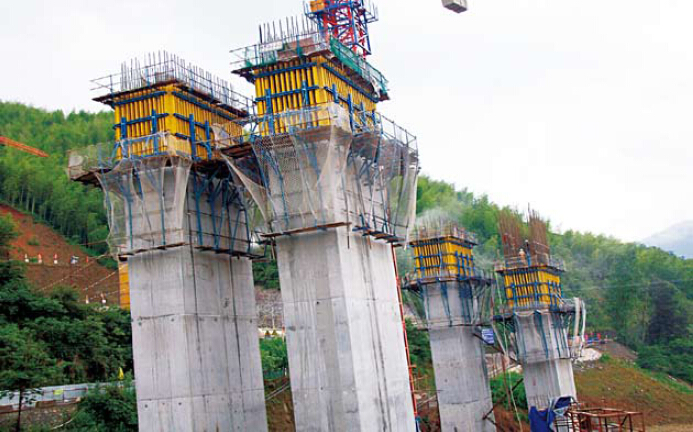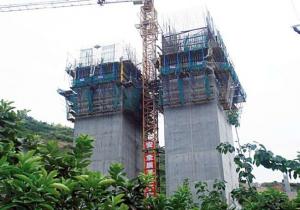Climbing Bracket for Formwork and Scaffolding system
- Loading Port:
- Tianjin
- Payment Terms:
- TT OR LC
- Min Order Qty:
- 50 m²
- Supply Capability:
- 1000 m²/month
OKorder Service Pledge
OKorder Financial Service
You Might Also Like
Climbing Bracket CB240 & CB210
They are framework brackets for supporting large-area wall formwork.
Typical applications for the CB240&CB210 are pier and column/shear wall/core walll/ in the
building.
CB210 has smaller size than CB240, it will be cost effective in some condition.
Characteristics:
◆ High bearing capacity
The high loading capacity of the brackets allow very large scaffold units. This saves the number
anchor points required as well as reducing climbing times.
◆ Simple moving procedure by crane
Through the strong connection of formwork together with the climbing scaffold, both can be moved
as a single climbing unit by crane. Thus valuable time-savings can be achieved.
◆ Fast striking process without a crane
With the retrusive set, large formwork elements can also be retracted quickly and a minimum of
effort.
◆ Safe with work platform
The platforms have assembled firmly with bracket and will be climbing together, without scaffolding
but can work safely in spite of your high location.


- Q:Can steel formwork be used for residential tower construction projects?
- Residential tower construction projects can indeed utilize steel formwork. Steel formwork has gained popularity within the construction industry due to its durability and versatility. Its robustness makes it an ideal choice for high-rise structures like residential towers, as it can endure high concrete pressures and deliver a seamless finish. One of the main advantages of steel formwork is its reusability, making it a cost-effective solution for large-scale projects. It is easily assembled and disassembled, enabling efficient construction schedules. Moreover, it provides exceptional support during concrete pouring and setting, ensuring accurate dimensions and alignment. Residential tower projects often require swift construction cycles, and steel formwork facilitates this by allowing for rapid and efficient concrete pouring and formwork removal. Additionally, it reduces reliance on highly skilled labor, as it can be effortlessly handled and manipulated. Nevertheless, it is crucial to consider the specific requirements and design considerations of each residential tower project. Factors such as tower height, load-bearing capacity, and architectural design may influence the suitability of steel formwork. Consulting with a structural engineer or construction professional is highly recommended to determine the most suitable formwork system for a specific residential tower construction project.
- Q:Can steel formwork be used for precast concrete arches?
- Precast concrete arches can indeed utilize steel formwork. This material, known for its versatility and durability, proves highly capable of constructing intricate shapes and structures, including arches. During the casting process, steel formwork offers exceptional support and stability, ensuring the precise and accurate formation of arches. Moreover, steel formwork easily adapts to various arch designs and dimensions, thanks to its customizable nature. Its strength and rigidity further enable it to withstand the pressure and weight of the concrete during the curing process. Consequently, steel formwork emerges as the preferred choice for constructing precast concrete arches due to its flexibility, strength, and reliability.
- Q:Can steel formwork be used for both thin and thick concrete elements?
- Yes, steel formwork can be used for both thin and thick concrete elements. Steel formwork is versatile and can be adjusted to accommodate different sizes and shapes of concrete elements. It provides strong and durable support, making it suitable for various construction projects.
- Q:Can steel formwork be used for sports complex construction projects?
- Yes, steel formwork can be used for sports complex construction projects. Steel formwork is a versatile and durable option for creating the desired shapes and structures required for sports complexes. It can be used to construct various elements of the complex, such as walls, columns, beams, and slabs. Steel formwork offers high strength and stability, allowing for larger spans and higher load-bearing capacity, which are often necessary for sports facilities. Additionally, the smooth finish achieved with steel formwork helps to create a professional and aesthetically pleasing appearance. Overall, steel formwork is a suitable choice for sports complex construction projects due to its strength, flexibility, and ability to create complex structures efficiently.
- Q:Can steel formwork be used in curved or irregular structures?
- Yes, steel formwork can be used in curved or irregular structures. Its flexible nature allows it to be easily shaped and adjusted to fit the desired curves and angles of the structure. Additionally, steel formwork offers high strength and durability, making it suitable for various construction projects, including those with unconventional shapes.
- Q:How does steel formwork help in achieving a high-quality finish?
- Steel formwork helps in achieving a high-quality finish due to its ability to provide a strong and rigid structure for concrete placement. Its smooth and non-absorbent surface prevents the formation of air bubbles, resulting in a smooth and even finish. Additionally, steel formwork allows for precise and accurate shaping and alignment, ensuring the desired dimensions and contours of the final concrete product.
- Q:How does steel formwork handle different concrete surface coloring techniques?
- Steel formwork is a versatile and durable option for concrete construction, but it does not directly impact the coloring techniques used on the concrete surface. The coloring techniques, such as staining, stamping, or painting, are applied after the concrete has been poured and cured. Steel formwork primarily focuses on providing structural support and shape to the concrete during the pouring and curing process.
- Q:Can steel formwork be used for architectural concrete walls?
- Yes, steel formwork can be used for architectural concrete walls. Steel formwork offers high strength and durability, making it suitable for creating complex shapes and designs in architectural concrete walls. It provides a smooth and even finish to the concrete surface, ensuring a high-quality aesthetic appearance. Steel formwork is also reusable, making it cost-effective for large-scale projects. Additionally, steel formwork can be easily assembled and disassembled, allowing for efficient construction processes. Overall, steel formwork is a popular choice for architectural concrete walls due to its versatility, strength, durability, and cost-effectiveness.
- Q:Can steel formwork be used for both simple and complex architectural designs?
- Steel formwork is a versatile option that can be used for both simple and complex architectural designs. It can be shaped and customized to different sizes and shapes, making it suitable for a variety of projects. Its flexibility allows for the creation of intricate and unique forms. In addition, steel formwork offers excellent strength and stability, enabling it to withstand the pressures and forces exerted during the concrete pouring process. This makes it an ideal choice for constructing structures with complex shapes and designs. Moreover, steel formwork is durable and can be reused, making it a cost-effective solution for projects involving both simple and complex architectural designs. Overall, steel formwork is a reliable and efficient option that can be used in a wide range of architectural designs, regardless of their complexity.
- Q:What are the considerations when designing steel formwork for slabs with openings?
- When designing steel formwork for slabs that have openings, it is crucial to take several important factors into consideration. These factors include: 1. Load-bearing capacity: The formwork needs to be able to support the weight of the concrete and any additional loads that may be applied during construction or usage. It should be designed to withstand these loads without experiencing excessive deflection or failure. 2. Durability: Steel formwork should be able to withstand the harsh conditions found on construction sites, including exposure to moisture, chemicals, and physical impact. The chosen material should be resistant to corrosion and have a high strength-to-weight ratio. 3. Flexibility and adjustability: Since slabs with openings often have irregular shapes and sizes, the formwork should be designed to be flexible and adjustable. This allows for easy customization and ensures a precise fit for the openings. 4. Support for reinforcement: The formwork should provide adequate support for the reinforcement bars or mesh used within the slab. It should be designed to accommodate the placement and spacing of these reinforcements, ensuring proper concrete cover and structural integrity. 5. Ease of assembly and disassembly: The formwork system should be designed for easy assembly and disassembly, as it will be used repeatedly for multiple slabs with openings. The components should be lightweight and easy to maneuver, allowing for efficient construction and reduced labor costs. 6. Safety: Safety is a top priority when designing steel formwork. The formwork should be designed to prevent accidents, such as slipping or collapsing, during assembly, concrete pouring, and removal. Adequate safety measures, such as guardrails and non-slip surfaces, should be incorporated into the design. 7. Cost-effectiveness: The design should aim to minimize material and labor costs while still ensuring the required strength and durability. Efficient use of materials and standardization of components can help reduce overall costs. 8. Compatibility with other construction systems: The formwork should be compatible with other construction systems, such as scaffolding or shoring, to ensure proper integration and coordination during the construction process. By considering these factors, designers can create steel formwork systems that are safe, durable, cost-effective, and efficient for slabs with openings.
1. Manufacturer Overview |
|
|---|---|
| Location | |
| Year Established | |
| Annual Output Value | |
| Main Markets | |
| Company Certifications | |
2. Manufacturer Certificates |
|
|---|---|
| a) Certification Name | |
| Range | |
| Reference | |
| Validity Period | |
3. Manufacturer Capability |
|
|---|---|
| a)Trade Capacity | |
| Nearest Port | |
| Export Percentage | |
| No.of Employees in Trade Department | |
| Language Spoken: | |
| b)Factory Information | |
| Factory Size: | |
| No. of Production Lines | |
| Contract Manufacturing | |
| Product Price Range | |
Send your message to us
Climbing Bracket for Formwork and Scaffolding system
- Loading Port:
- Tianjin
- Payment Terms:
- TT OR LC
- Min Order Qty:
- 50 m²
- Supply Capability:
- 1000 m²/month
OKorder Service Pledge
OKorder Financial Service
Similar products
New products
Hot products
























